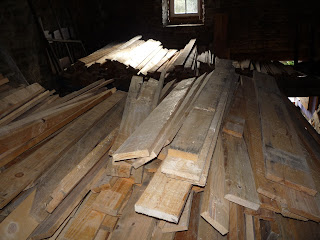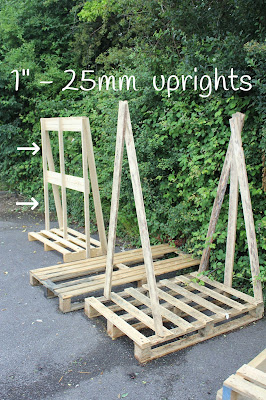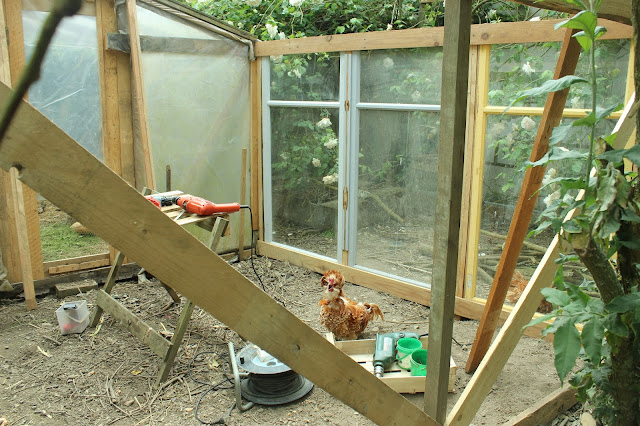I've already just touched on this habitat in my article on encouraging pair bonding and nesting which you can find, here but below you will find a detailed account of the design criteria and physical build. Just to reiterate though, the reason for this build was to create an 'open', natural environment, where my quail would be safe to pursue their wild breeding and sleeping habits, i.e with the illusion of an open space but without the threat from predators. Once my quail started to pair bond and create designated nesting sites, I realised that despite their trust in me, any interference on my part, such as putting them away at night, or covering the nests, interfered with the quail's behaviour patterns and disrupted their relationships. Thus they needed to have a stable and safe environment.
Choice of Site
As you can see below, in our forest garden, we didn't exactly have a great deal of choice as to where to site the quail safe house!
The choice of making it an addition to an existing building was an obvious one for three reasons:
- the quail already knew this greenhouse space, in fact it was there preferred one and they had started to nest in it,
-
it was protected from the prevalent Westerlies by the back of a neighbouring longhouse,
-
it additionally had the trellis arbour adjoined to it and this would allow yet another space for the quail to use, during the day, as it is potentially open to predators after dark.
Design Criteria
This new quail home/greenhouse was to have very specific criteria due to its unique position and function but these are actually in reality minor in structural design and no way preclude it from being useful for a multitude of purposes including just growing 'predator-free' food. In particular round here we have field voles, who have a brilliant and clever way of eating root vegetables by hollowing them out slowly and methodically, so you don't realise what's happening until all of a sudden a whole row of beetroot, for example, will suddenly wilt and keel over!
Here are the criteria for the quail safe house:
- all year round outdoor living
- an environment that encourages pair-bonding
- safety from predators above and below
- a planted environment, which will sustain itself
- an environment which encourages the proliferation of arthropods
- a roof that could be partially open (or covered) to allow access for rain and direct sunlight (vitamin D₃)
- a windproof environment except from the South (we get Atlantic breezes)
- an illusion of being open and spacious but without dangers
- natural materials which blend well with our forest garden
- would not interrupt the view; so built on a slight angle to blend into the vista or enfilade, which flowed from the trellis arbour, and existent greenhouse*
- easy care and maintenance
- can be built of recuperated/recycled materials
- can be added on to an existing and favourite greenhouse of the quail to allow for them to access that additional space when vegetables/fruit were above quail height**
- big enough footprint to allow a group of 12 or more quail to feel unpressured and able to form their own mini territories.
- allows the rose bushes at the side of the planned extension to get good access to light
* Garden Room with a View
** The recycled glass window at the end of the greenhouse was to be removed and replaced with a doorway to access the new build quail house. This was the greenhouse the quail seemed most at home in!
Materials & Measurements
The design (and thus the materials needed) is informed by the dimensions of the window frames to be used.
For example, we had already recuperated 3 identical pairs of double-paned, single glazed casement windows. These frames measured as follows:
Each pair was:
width 60" (1535mm)
height 57" (1440mm)
thickness 1½" (35mm)
The thickness of the frames you choose is crucial, as this sets the thickness of the posts, which were made from sandwiching together two pallet uprights. I will explain this further when we come to the section on fitting the windows. These planks, we can find easily at plumbers, glaziers and general carpenters.
For the rest of the material I drew from our collection of untreated pallet wood, you can find all the information on identifying untreated pallets and breaking them down for carpentry here on our other site: The Green Lever and there is a link to the relevant articles at the end of this one (plus more chicken coop designs).
The breakdown of the pallet wood used is as follows:
For the roof: 16 standard pallet wood planks of ¾" (20mm) thickness, plus...
For the stops and and ridge connecting pieces a couple of pallet planks or uprights of 1" (25mm) thickness
For the support posts for the walls 9 uprights - this is because each upright can be cut in half lengthwise to furnish one post.
For the supporting frame of the greenhouse boards and roof purlins 18 extra long pallet planks 8' (2540mm)Laths cut from pallet wood (approximately 1 standard pallet) to attach the polythene.
200 micron UV-Stabilised Horticultural Grade Polythene 130ft² - 12m²
Chicken wire (optional) to cover between the first and second roof truss. This is then covered in Winter with screw on frames of polythene (see film)
Screws and Nails
I had already changed the recuperated window at the back of the existent greenhouse for a homemade pallet wood door, some time previously. You can see this door below left in an image we took partway through the build, with the Site Manager looking on
in Part Two which you can access here, we will look at the detailed step-by-step build.
Thanks for dropping by and do feel free to share experiences or ask for further information in the comment section. If you have enjoyed this piece and found it useful think about sharing it with your family and friends, on social media and also maybe about joining this blog and/or subscribing to my Youtube, Odysee or BitChute Channel or even supporting us on Patreon or
Until next time, all the very best from sunny Normandie!
© 2021 Sue Cross
RELATED ARTICLES
Creating A Safe Quail Area Part 2 - The Build
Encouraging Pair-bonding, Nesting and Broodiness in Coturnix Quail
Tips and strategies for raising natural organic quail chicks
 A Few Guidelines for Collecting Pallets
A Few Guidelines for Collecting Pallets
Pallets - The Low-down - Where, What and How.
How to Dismantle Pallets for free Carpentry Wood














